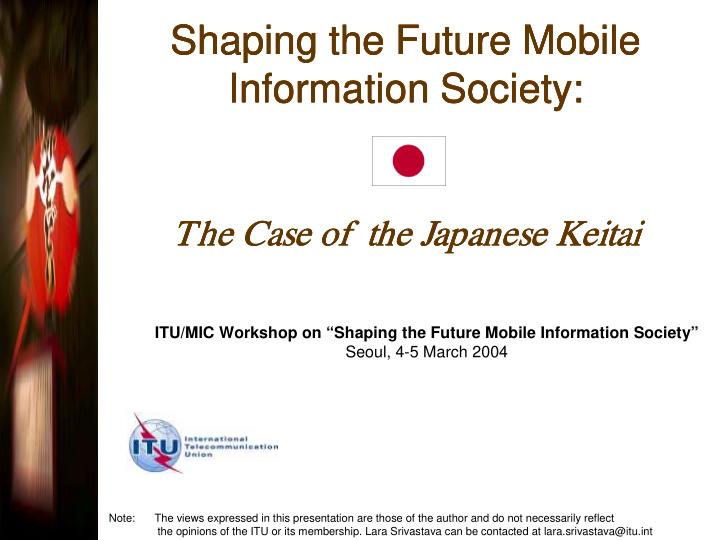



Shaping the Future Mobile Shaping the Future Mobile Shaping the Future Mobile Shaping the Future Mobile Information Society: Information Society: Information Society: Information Society: The Case of the Japanese The Case of the Japanese Keitai The Case of the Japanese The Case of the Japanese Keitai Keitai Keitai ITU/MIC Workshop on “Shaping the Future Mobile Information Society” Seoul, 4-5 March 2004 Note: The views expressed in this presentation are those of the author and do not necessarily reflect the opinions of the ITU or its membership. Lara Srivastava can be contacted at lara.srivastava@itu.int
International Telecommunication Union The “Keitai” Calculation Total mobile subscribers, top 10, 2002, millions China 206.6 United States 140.8 Japan 81.1 Germ any 59.2 Mobile Internet subscribers as a percentage Subscribers to Fixed and Mobile Services in Italy 52.3 of total mobile subscribers (2002) Japan, 1996-2002 (millions) United Kingdom 49.9 90 Japan 79.2% France 38.6 80 Korea (Rep.) 74.9% Brazil 34.9 70 33.5 China Spain 33.9% 60 Korea (Rep.) 32.3 Argentina 33.0% 50 Finland 29.1% 40 Canada 20.0% 30 Germany 13.8% 20 Singapore 12.0% 10 France 11.7% 0 United States Source: ITU 8.9% 1996 1997 1998 2000 2001 2002 2 MPHPT
International Telecommunication Union The “Keitai” Context • Success of mobile Internet • Operator-led mobile sector • Revenue-sharing for content • Early introduction of IMT-2000/3G services, including e.g. video services • Recent introduction of flat-rate 3G billing • Ubiquitous network society – Active governmental programmes and policy 3
International Telecommunication Union Mobile: not only for ‘on the move’ Location when using mobile browser (2002) 63.2% Location when making mobile calls (2002) 31.7% 23.9% 21.1% 46.2% 12.7% 9.4% 38.3% At home In transit Workplace Station or Public In transit (in 33.7% (train, bus) or school bus stop place (e.g. a car) 30.4% shop) 23.8% 11.7% At home Workplace Public Station or In transit (in In transit or school place (e.g. bus stop a car) (train, bus) shop) 4
International Telecommunication Union New applications and services • Audio and video • Location-based services • Mobile gaming • Multimedia home Top reasons for using the Mobile Internet in Japan (2002) E-mail 83.3% • In-vehicular Music 45.8% applications Paid content 37.3% Wallpapers 34.8% etc.. • Vending News/Weather 31.5% and ticketing Shopping 19.9% Info search 18.1% 5 Source: MPHPT, 2002
International Telecommunication Union The case of chips and codes • RFID – Roppongi Hills trial – read or shop or… – Eat: RFID and sushi – Implications • The DoCoMo 2D Code – With this, mobile can read data from a simple code – May eventually embed hyperlinks – A first step to the T-Engine Forum’s “ Ubiquitous Communicator ”? 6
International Telecommunication Union Keitai Device Evolution DoCoMo SO504iC With Felica card for payment/transport DoCoMo SH2101V PDA-style terminal with detachable pen-sized handset TU-KA TS41 First “sonic speaker” handset with bone conduction technology Vodafone V601N 7 With built-in TV tuner
International Telecommunication Union Protecting Data and Consumers • Camera phones and privacy • Chat rooms and dating sites • Enhanced personal ID functions – and accessories DoCoMo F505i With fingerprint sensor 8
International Telecommunication Union The Japanese mobile “etiquette” • A time and a place? • Industry self-regulation – Restaurants – JR Railway – Shinkansen • Individuals – Awareness – Etiquette 9
Strategy and Policy Unit International Telecommunication Union Thanks! Thanks! www.itu.int/futuremobile Vision without action is a daydream. Action without vision is a nightmare - Japanese poem lara.srivastava@itu.int
Recommend
More recommend